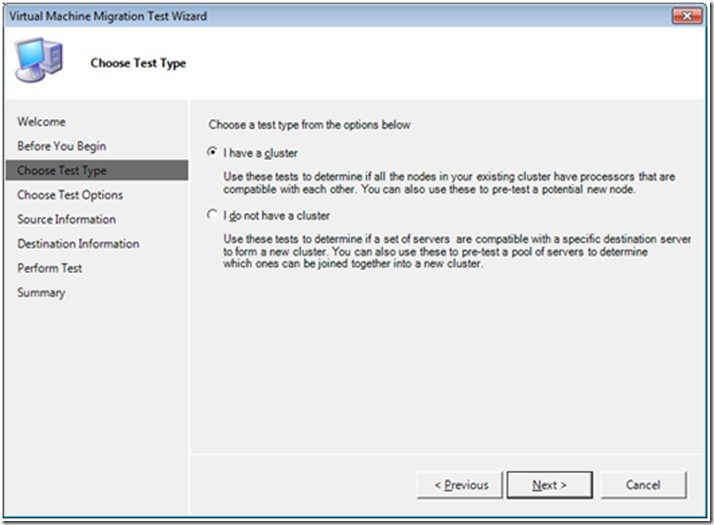Hyper-V How To: Test Hosts for Proc Compatibility for VM Migration
In Windows Server 2008 R2 Hyper-V R2, when a running or a saved state virtual machine is migrated to another virtualization server (also called “host”), the destination server may have a processor with a different set of features. An operating system or application that attempts to execute CPU features discovered when the virtual machine was started on a "source" machine, but not present on the destination (called "destination") machine, will cause a virtual machine migration failure.
The Hyper-V R2 virtualization platform prevents the migration of a virtual machine that will fail in this way because the processors of the "source" and "destination" servers are not compatible. However, this check for compatibility only happens at the time of virtual machine migration, not when the server joins a cluster.
Windows Server 2008 R2 includes a capability called “Processor compatibility mode” so that you can avoid the situation where virtual machines cannot be migrated due to processor incompatibilities. However, if you do not want to turn this capability on for each of your virtual machines, you can use the free-as-in-beer Virtual Machine Migration Test Wizard to identify which machines in your environment are compatible.
You can use the wizard before you have clustered any hosts to show you pools of servers that are processor compatible. The wizard covers four use scenarios:
Test compatibility of Processors on all the nodes of your existing cluster
- Use this scenario to determine if all the nodes in your existing cluster are compatible with each other so that you can avoid the situation where virtual machines cannot be migrated due to processor incompatibilities. In this scenario the cluster will be selected as the source information and no destination information is required. Finally a report will be generated where the servers will be grouped based on their compatibility.
Pre-Test a new Node to add to an existing cluster
- Use this scenario to validate a potential new node for processor compatibility with all the nodes of an existing cluster. Select the existing cluster as the source and the potential new node as the destination. Finally a report will be generated where the new nodes will be grouped based on their compatibility with the existing cluster nodes.
Pre-test a group of new Nodes to a specific destination Server
- Use this scenario to determine if a set of new servers are compatible with a specific destination server. Select the existing server as the source and the potential new nodes as the destination. Finally a report will be generated where the compatible servers will be listed in the same group as that of the selected source server.
Pre-Test a server pool
- Use this scenario to determine if a set of servers are compatible with each other so that we can form a cluster of the selected servers. Select the group of servers as the destination. Finally a report will be generated where the selected servers have been divided into compatibility groups. You can form a cluster with servers in the same group with which you can move virtual machines between the servers.
Want to read the doc before downloading the wizard? See https://code.msdn.microsoft.com/VMMTestWizard/Release/ProjectReleases.aspx?ReleaseId=3326.
Note: You’ll run this wizard on a server, pre-reqs include:
- All machines to be checked for compatibility, including the machine that is running this wizard, must be in a domain environment.
- Operating systems on all the machines to be checked must be Windows Server 2008 R2 and Hyper-V Role must be enabled.
- The User Account you use for this wizard must have local administrative privileges on all machines to be checked.
- .Net Framework version 3.5 must be installed on the machine running the wizard.
You can watch a video with Dinesh explaining/demonstrating the Virtual Machine Migration Test Wizard here.

